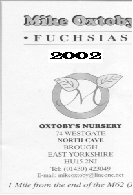|
rows of 8 cuttings, all of the same variety in each row. Cuttings are kept at 45°F just sat on the greenhouse bench but out of direct sunlight where they root in approx. 3-4 weeks. This is his preferred method though he acknowledges that there is more than one way - the important thing is to get the humidity right.
For growing standards it is imperative to start with even leaved cuttings and as they develop keep removing the side shoots from axils below the top four branches. Recommended stopping is at third pair for bottom branches (or 2nd depending on variety), at second pair for 2nd and 3rd set of branches and at one pair for the top. This should create a shapely head. Don't remove leaves until the head is well developed. When cutting leaves off leave about ¼" of stalk, which will fall off naturally in a few weeks time. This way tearing, which can leave wounds through which deseases can enter, is avoided.
Regarding variegated foliage varieties George reckons Sunray is so much nicer than Tom West and should be grown much more - though difficult to overwinter. Maybe easier now that multipotting is allowed enabling a bigger plant to be grown more quickly, even in one season.With Sunray make sure to take a cutting with a lot of vigour, you'll get the colour anyway as the plant develops.
A warning regarding multipotting. Multipotting means more plants = more foliage = more potential leaf drop. These dropped leaves must be retrieved regularly with tweezers or else botrytis is sure to appear. He not only removes these dead leaves but also some good ones, those that are touching others, to assist good airflow.
His self built wooden greenhouse has plenty of head room for hanging pots, which he grows from September cuttings, potting on to 3½ and 5 dwarf and then into the hanging pots. They are stopped at the top for shape, lavished with plenty of TLC, stroked into shape and talked to! Some of his favourite varieties are Tin Teardrop which covers the pot well and flowers well into autumn and Janice Ann.
For those of us who have wondered how best to treat the species, George has a great guideline, treat them like triphyllas for stopping and you are never far wrong. With species there is such an array of difficult ones which we all like, but in the end most think if you can't beat them join them and hence it is no wonder F. glaziona is so popular now.
With a Bonsai class appearing for the first time on our show schedule, naturally, we were keen to find some hints and tips on this subject. Bonsai has featured in our question section of most monthly meetings. This was just up George's street, he took it up as a hobby about six years ago. "You must have some idea what tree you are trying to grow. Take photographs and try to copy, using copper wire to achieve the desired shape. Trim roots by cutting off some of the verticals. At the end of the season clean ½" off the bottom and add new compost. Draw compost back to expose roots at base of the plant. Training bonsai takes a lot of time, however, as an easy alternative way you can, at the end of the season, select one of the seedlings just left to its own devices in the border which, hey presto, is a ready made bonsai! Your bonsai fuchsias can be grown in normal compost (= 6 parts by volume of peat, 1 part grit and 1 part perlite), but more stability can be gained by replacing the perlite by more grit. In hot weather the established plants may need watering twice a day, so you'll need a good friend, like me, I've got Ken Pilkinton!" No special feed is required, George uses the 1/1/1 Sangral feed once a week (nice job for Sundays) or you can use diluted Maxicrop every time you water for equally good results.
|
|
